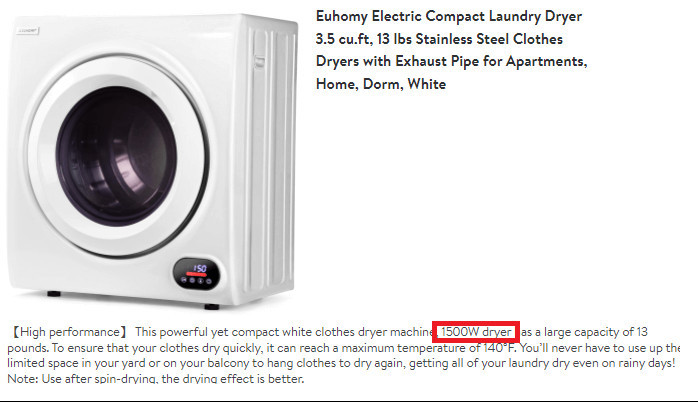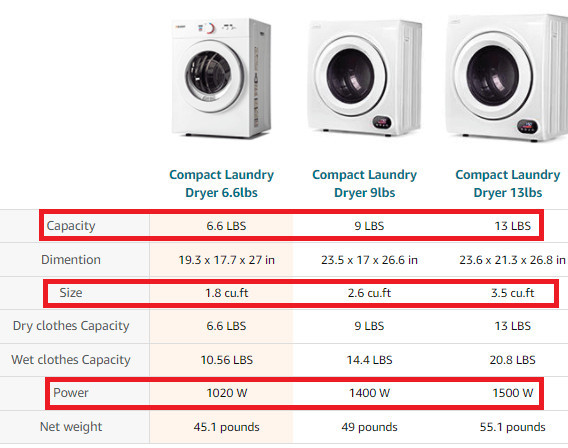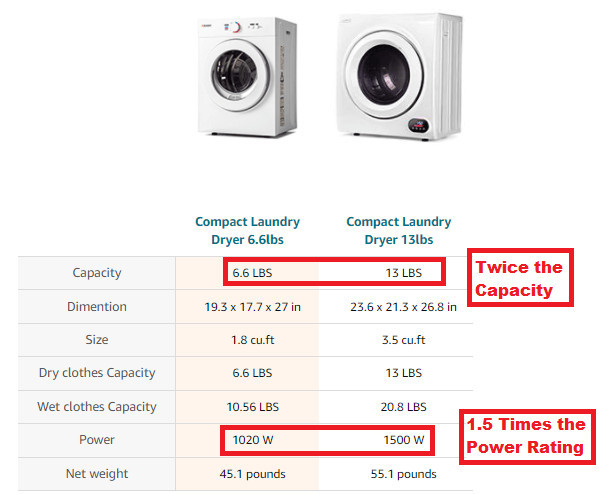Electric dryers can be time saving instead if you don’t want to hang clothes and wait for natural drying, and could be useful for small places where there’s not enough space to hang wet clothes in the first place.
But do tumble dryers use a lot of electricity and add a lot to your bill?
How much do they cost to run per cycle, and per month?
And how to pick the right tumble dryer in order to keep its energy consumption and running cost as low as possible?
These questions and more, I will be answering in this short article in order to help make the right decision when purchasing an electric dryer.
Without further ado, let’s jump in!
Do Tumble Dryers Use a Lot of Electricity?
Tumble dryers are one of the appliances that use a lot of electricity when they are running like space heaters and air conditioners, but the dryer’s total energy consumption per month might not be that significant as they don’t run as often or as long as other big appliances do.
The total electricity usage of tumble dryers depends on three things:
- The power rating of the tumble dryer that depends on the size and the mode it is using.
- The total drying cycle time.
- The number of cycles the tumble dryer is doing.
Recommended for US Homeowners:
Related: Worried about Your Next Electricity Bill? Here’s How 1,000’s of US Homeowners Get Almost $0 Bills!
Related: Are You Missing Out on This Tax Credit Opportunity? (And 3 Other Benefits!)
How Much Electricity Does a Tumble Dryer Use?
On average, a tumble dryer uses around 1,500 watts of electric power when its running, which translates into 1.5 kWh (kiloWatt-hour) of electric energy per hour, which is what the meter records.
The total energy a tumble dryer uses per drying cycle is around 4.5 kWh per cycle on average as the full drying cycle takes around three hours to finish.
Note that some tumble dryers have different power ratings as they have capacities for the load size they can take.
Also, many tumble dryers have different operating modes such as: hot air mode, warm air mode, Eco mode, …etc., and each one draws a different amount of electricity and lasts for a certain time duration, which affects the total energy consumed by the tumble dryer.
This makes the electricity consumption differ from one cycle to another on the same dryer, and from one dryer to another.
How Much Electricity Does a Tumble Dryer Uses per Month?
A tumble dryer uses around 36 kWh of electricity per month, assuming that you do laundry twice a week like many people do, with the average consumption of 4.5 kWh per drying cycle.
The actual energy consumption per month differs from one user to another depending on the size of the tumble dryer, the mode it works on, and the number of loads that it is used to dry out per month.
Are Tumble Dryers Expensive to Run?
While tumble dryers can use a lot of electricity when running, but they might not be that expensive to run as you don’t do laundry every day.
However, if you have a big family, and if you do laundry more often than usual, and you live in a place where the energy rates are high, then the tumble dryer might cost you a lot.
How Much Does a Tumble Dryer Cost to Run?
On average, a tumble dryer costs around 63 cents per cycle, assuming the average rating of 1,500 watts, the cycle energy consumption of 4.5 kWh, and the average price of 14 cents/kWh.
That’s 4.5 kWh/cycle X 14 cents/kWh = 63 cents per cycle.
The tumble dryer costs an average of 21 cents to run per hour based on the average dryer rating of 1,500 watts and the average electricity price of 14 cents/kWh.
That’s 1.5 kWh/hour X 14 cents/kWh = 21 cents/hour.
With the previous example, assuming that you run the tumble dryer twice a week and it ends up consuming 36 kWh per month, the total cost to run the tumble dryer per month is around $5.04 per month.
That’s 36 kWh/month X 14 cents/kWh = 504 cents/month or $5.04/month.
The actual cost of running a tumble dryer would differ from users to another depending on:
- The actual tumbler dryer with a different power rating, or if you are using a different mode that could consume more or less energy.
- The mode you leave it on.
- How many cycles you run it per month, which depends on how many times you do laundry and how big the lead is.
- The electricity prices in your area as different energy companies charge different rates.
For example, assuming that you run a 1,500-watt tumble dryer that uses around 4.5 kWh per cycle for eight times a month, totaling 36 kWh used, but in a place like Connecticut, where the energy rates are around 23 cents/kWh, then the total cost per month would be:
36 kWh/month X $0.23/kWh = $8.3/month.
While in other places like Idaho, where the rate is around 10.6 cents/kWh, the monthly cost for the same usage would be:
36 X $0.106 = $3.8/month.
Note that it if you have a big family or big loads of laundry, then it is better to get a dryer of a bigger capacity that does one big load, instead of using a smaller tumble dryer that has to do two cycles in order to dry out the same size of laundry load.
For example, the Euhomy 3.5 cu.ft. tumble dryer have double the capacity (load size) of the Euhomy 1.8 cu.ft. dryer, but it consumes around only 1.5 times the energy used by the 1.8 cu.ft. dryer per cycle.
This means, that running the bigger dryer on a full load uses less energy in total when compared to running the smaller dryer for two cycles in order to dry out the same amount of laundry. and thus, it costs less.
Is it Cheaper to Run The Tumble Dryer at Night?
In some places where the utility company charges different rates during the same day based on the TOU (time-of-use) tariff, it might be cheaper to run the tumble dryer at night during the off-peak hours when the electricity price is lower.
I have answered this in detail in my article about the best time to do laundry and save energy.
To know what time of the day is considered off-peak, check out the website of your energy provider, the bill they issue, or call them to ask about the rates and the timing of each rate.
Some companies might have a fixed rate through out the day, and it does not matter when you run the dryer, but running it during the day in the hot summer days might cause it to emit heat, which then increases your air conditioning bill.
How to Choose Energy Efficient Tumble Dryer?
Here are some tips on how to pick an energy efficient tumble dryer that would keep the running costs to a minimum:
- Choose the right size or capacity in order to do full loads with the smallest number of drying cycles, and you can use the washing machine size as a guide for your needs.
- After deciding the load capacity, select one with the lowest kWh consumption, which depends on two parameters: the power rating in watts, and the time of each drying cycle. Some dryers’ manufacturers might give you an estimation of energy usage per cycle, and some might give you an estimated annual usage, but you need to know the estimates were made based on how many cycles per year.
- Choose an Energy Star certified tumble dryer as these use less energy than the other dryers of the same capacity in the market.
Conclusion
As you can see, the amount of energy and the running cost for using a tumble dryer differs based on the size of your dryer, the frequency of doing laundry, and the price of electricity in your area.
The tumble dryer uses a lot of electricity when it is running, but the total energy consumed by the dryer might be low as you don’t need to run it as often as you do with other big appliances such as water heaters and air conditioners.
But in general, the cost of running a tumble dryer isn’t that high, unless you use it almost every day, and if you live in a place where the electricity rates are way higher than the average.
But sometimes, it is necessary to use the dryer if you don’t have enough space for hanging cloths, or if you live in a location where it is cold most of the year and it takes a long time to naturally dry out clothes.
Follow the tips in the previous section in order to select the right tumble dryer and keep your energy costs the lowest.
I hope that this short article was helpful.
If you still need help on this topic, or if you have other questions, please, let me know in the comments’ section below, and I will do my best to help you out







